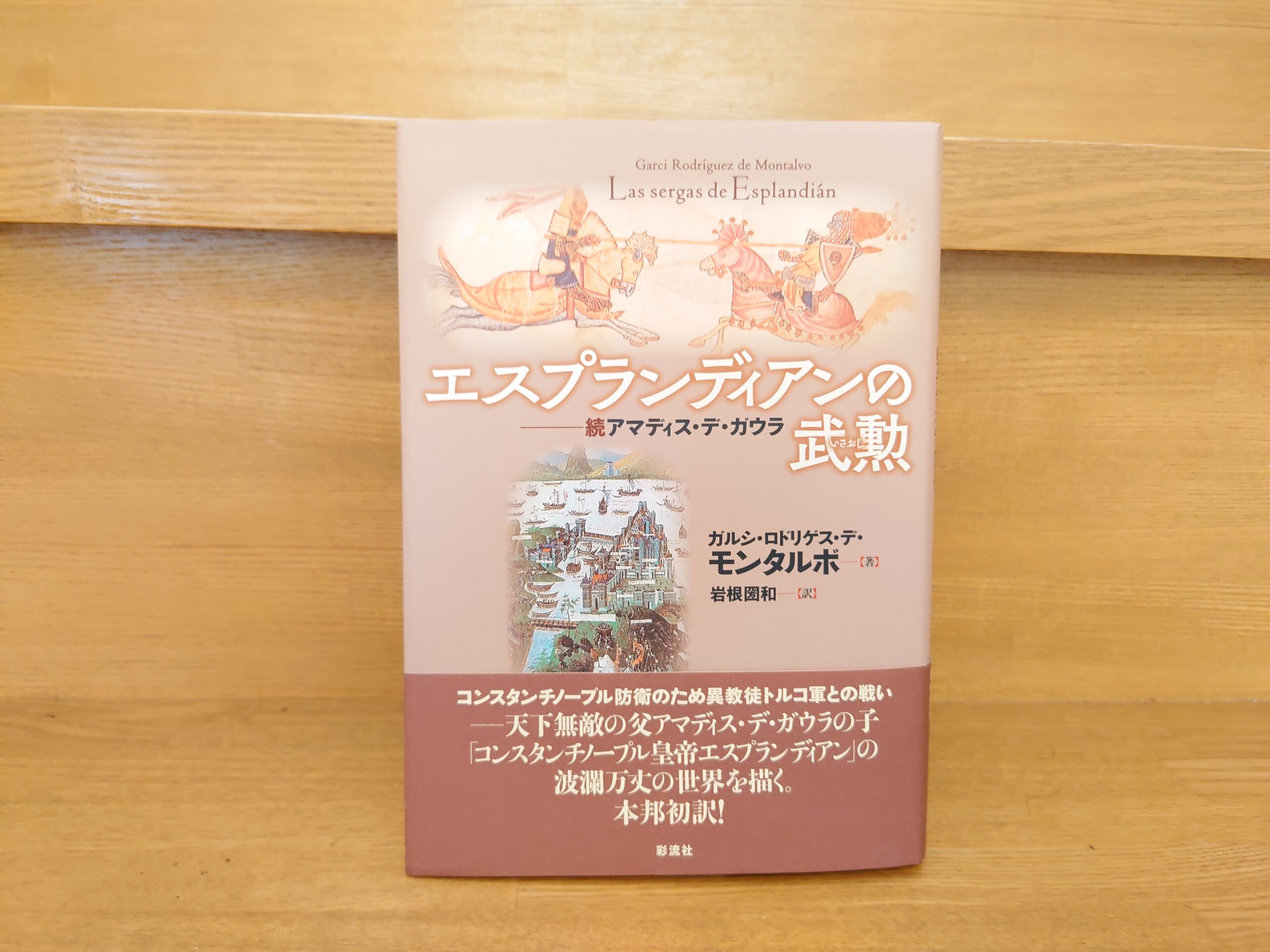Montalvo's "Esplandian Armed Order: The Sequel Amadis de Gaula" Synopsis and Comments - The Story of Amadis' Son, the Knight Admired by Don Quixote.
I would like to introduce to you "The Esplandian Buxom Sequel Amadis de Gaula" published by Montalvo in 1510. I read "The Esplandian Warrior Order Continued Amadis de Gaula" translated by Kunikazu Iwane, published by Sairyusha in 2019.
Let's take a quick look at the book.
Fighting the Pagan Turks for the defense of Constantinople
AmazonProducts Page.
--Amadis de Gaula's son, the father of the invincible Amadis de Gaula
The vicissitudes of "The Emperor of Constantinople, Esplandian"
A classic masterpiece of a book about the world.
Sequel to the Spanish version of the "Tales of Chivalry," Amadís de Gaura.
First translation in Japan!
Previously, in the article "Montalvo's "Amadis de Gaula" Synopsis and Impressions - A masterpiece of chivalric tales that drove Don Quixote mad!"In the following section, we introduced the chivalric tale "Amadis de Gaula," which led Don Quixote to lose his sanity.
This work, "The Order of the Esplandian Warrior," is a sequel to that work.
The protagonist is Esplandian, the legitimate son of Amadis de Gaula, the protagonist of the previous film.
About this work by Kunikazu IwaneDon Quixote's Social History of Spain.The following is explained in the following section.
The book tells the story of the exploits of Esplandian, the legitimate son of Amadis and Princess Oriana, the future emperor of Constantinople. Esplandian, a man of incomparable beauty, preaches that the highest aim of knighthood is not the pursuit of worldly honors, such as love or military deeds, but the pursuit of Christian perfection, and the author, Montalvo, often appears as the narrator of the book, preaching the change of destiny and reminding us to fear God, leaving behind the sin of luxury and pride.
He explains the teaching of the Old Testament that to believe in God is first to fear God, and he persistently repeats that kings and princes must leave the sin of arrogance and serve God. He then goes on to say in a laconic tone that when those in high places become conceited and commit the sin of arrogance, their destiny is reversed and they fall into the abyss. The protagonist, Esplandian, who is also a bright and shining figure, also admonishes the Catholic faithful to believe in grace with all their hearts before God and to turn away from the sin of arrogance.adviceThe first is the "I" in "I".
His enemies are not his fellow countrymen, Christian knights, as in the case of his father Amadis, but pagans, enemies of God, represented by the Turks. His primary objective is to defeat the pagans and convert them to Christianity, and as a devout Catholic, he is dedicated to the task of spreading the teachings of Christ, risking death in the process. This is a drastic change of pace from "Amadís de Gaula," but it is clear that in the rush to do so, the plot has become a bit forced.
For example, after the defeat of the hated pagan warrior Flandaro, he converted and became the second and only collaborator of the Esplandians, playing an active role in all aspects of the story, or Queen Calafia, a warrior woman from California Island, fell in love with an Esplandian and eventually married another knight after her conversion. The plot of the story, in which Calafia, a female warrior queen of California Island, falls in love with an esplandian and eventually marries another knight after her conversion, cannot help but leave us with a sense of discomfort.
And if Cervantes was more or less displeased with the monotony of his relentless repetition of devotion as a devout Catholic knight, away from the spirit of chivalry, than with "Amadís de Gaula," which depicts a fierce duel between Christian knights, it is understandable that he would easily throw "The Orders of the Esplandians," a sequel to "Amadís de Gaula" that he had praised so highly. If Cervantes was in any way displeased with the monotony of his relentless repetition of pious Catholic knightly devotion, it is understandable why he would so easily throw into the fire the sequel to his highly praised "Amadis de Gaula," "The Esplandian Armor.
Sairyusha, Kunikazu Iwane, Don Quixote's Social History of Spain, p. 18-19.
Some line breaks have been made.
This work is honestly quite inferior to its predecessor, "Amadis de Gaura".
I can actually read it, but what can I say, it is not "exciting".
In "Amadis," the clash of wills between knight and knight, or man and man, was loud and exciting, and it told the exciting story of how to get out of a tight spot.
However, the story is not told in "The Order of the Esplandian Warrior" for some reason.
Yes, there are fight scenes, but they are very monotonous. I feel something is missing.
As mentioned in the commentary above, this work is not about battles between knights, but about battles with pagans.
In the previous work, there was a psychological drama of how the knights stood up to each other in their respective positions, and there were attractive characters in spite of their enemies.
However, this work is rather monotonous, with only the heavenly esplandian defeating demonic infidels in the name of justice. It would have been nice if there had been some fascinating enemies or some psychological drama, but there is little of that. This is tough! I felt I could understand why Selvandes criticized this film so harshly.
Now, the "Amadis de Gaura" and the "Esplandian Armistice" that I have introduced so far appear clearly in the work of "Don Quixote" in the first part, chapter 6, the story of the "Burning Innocence".
In fact, this "book burning inquiry" is my favorite episode of "Don Quixote". It is so humorous and witty that I have never seen such an exchange.
We previously discussed this episode.The connection between the recommended episode of "Don Quixote," "The Story of the Burning Inquisition," and the Inquisition: "Learning from the Medieval Inquisition" ⑽"I have already introduced it in my article on the "What is the best way to make the most out of the newest technology?
What is the story of the book burning investigation in "Don Quixote"?
One day, Don Quixote loses his senses and sets out on a journey alone in secret. However, he was caught up in a calamity, and the villagers found him so battered that he was unable to move, and took him home.
Don Quixote's family is already in an uproar when the master, who secretly ran away from home, returns home in tatters.
Don Quixote, completely exhausted, is sleeping soundly in his room. While he is sleeping, his family, a priest and a barber, who were close to him, try to burn Don Quixote's books, which started the whole incident. The scene begins as follows
Chapter VI.
On the amusing and extensive examination of the books conducted by the priest and the barber in the library of our resourceful townshipDon Quixote was still asleep. When the priest asked the niece of the township official for the key to the room where the book that had caused the disaster was kept, she gladly gave it to him. The housekeeper arrived, and together with the barber, the four of them went inside, where they found more than a hundred thickly bound books in splendid bindings, as well as several smaller books. As soon as she saw the books, the housekeeper left the study in a panic, but soon returned with a large container of holy water and an irrigator in her hand.
Now, Bishop, please sprinkle holy water on this room to purify it. Some of the wizards who are crawling with books might know that we are about to expel them from the world and might try to bewitch us to spite us.
The scholar chuckled at the housekeeper's naivete, but he did not care; he asked the barber to hand over the books one by one so that he could check their contents. She asked the barber to hand over the books one by one to check their contents, as some of them might not be worthy of being burned.
No, you can't," my niece interrupted Ro. I will not pardon a single book, because every single one of them has been involved in wrongdoing. It would be quicker to throw them out the window onto the patio, pile them up, and set them on fire. If the patio is not good, take them to the backyard. There you can build a fire, and it won't matter how much smoke comes out.
The housekeeper shared the same opinion. Both women were so passionate in their wish for the death of these innocent books. The priest, however, disagreed, insisting that at least the titles of the books needed to be read. Thus, the first book that Oyasama Nicholas handed to the priest was the "Amadis de Gaula," in four volumes, and when the priest saw it, he said, "I have read it.
This must be some kind of a coincidence, because, according to what I have heard, this was the first book of chivalry printed in Spain, and all others are modeled after it. I have heard that this was the first book of chivalry printed in Spain, and that all others were based on it and modeled after it. Therefore, it seems to me that he should be mercilessly burned at the stake for being the founder of such an evil sect's doctrine."
No, you can't do that, priest," the barber objected. I have heard that it is also the finest book of its kind ever written. It should therefore be exempted from execution as the pinnacle of the art of storytelling.
The priest responded, "I see, my master is right. In that case, I'll save your life for today. Now, let's see the one next to it, shall we?
This," said the barber, "is the story of the legitimate son of Amadis de Gaura, that is, the 'Esplandian Warrior Order.'"
Ho-ho," the priest responded, "but how can the greatness of a father extend to his son? Now, housekeeper, open the window and throw this out into the backyard. Let this book be the foundation for a great bonfire that will soon begin."
The housekeeper happily did as she was told, and the good-natured esplandian flew to the backyard, where he waited patiently for the flames to catch up with him.
Now let's move on," the priest nudged.
Next up," the barber received, "'Amadis de Grecia,' but as far as I can see, everything in this row is the story of the Amadis family."
Then the whole family is going to the back yard," the priest exclaimed. I wouldn't mind burning my own father to get rid of Queen Pintikiniestra, herdsman Dalinell, and the pastoral songs he sings. But only if he was walking around dressed as an itinerant knight."
The barber took over, saying, "I agree with the priest.
Me too," my niece agreed.
When it is decided," said the housekeeper, "come on, come here. I'll take it to the backyard."
So the books were given to the housekeeper, which amounted to quite a few, and she tossed them out the window, saving the stairs.
Who is that ridiculously large one? the priest asked.
Here's the 'Don Olivante de Laura,'" the barber replied, "and here's the reserve."
The author of that book," the priest continued, "is the same person who wrote 'The Garden of a Hundred Flowers,' but frankly speaking, I cannot decide which of the two books is more truthful, or rather, which is less false. All I can say is that the book is so full of hubris and bullshit that it is destined for your backyard."
The barber said, "The next one we will see is 'Florimorte de Ircania.
Oh, there you are, Florimorte," the priest responded. I see," replied the priest, "that his strange birth and spectacular adventures are quite impressive, but with that stiff and tasteless style of writing, there is no choice but to take him back to the backyard as soon as possible. Now, housekeeper, please send this to the backyard along with the other one."
Iwanami Shoten, Selvandes, Don Quixote, translated by Nobuaki Ushijima, ㈠P112-116
The way the priest and the barber say it is so humorous and funny. I really love this scene.
These exchanges will continue after this. I have only introduced a small part of it in this article, but I hope you will read the novel as well. This scene can be seen right after page 100 of the first volume. The famous adventure of the windmill also appears right after this.
Amadis de Gaura managed to escape execution, but unfortunately, the decision was made to burn him in the stake.
This," said the barber, "is the story of the legitimate son of Amadis de Gaura, that is, the 'Esplandian Warrior Order.'"
Ho-ho," the priest responded, "but how can the greatness of a father extend to his son? Now, housekeeper, open the window and throw this out into the backyard. Let this book be the foundation for a great bonfire that will soon begin."
The housekeeper happily did as she was told, and the good-natured esplandian flew to the backyard, where he waited patiently for the flames to catch up with him.
Cervantes dismisses Esplandian very easily. I think this is because, as I also felt when I read this work, it was not as interesting as I would have liked it to be.
Nevertheless,The good Esplandian danced in the backyard, where he waited patiently for the flames to close in on him."I can't get enough of Cervantes' way of saying, "I'm not sure I'll ever be able to do that. I can't help but smile no matter how many times I read it. I wonder if there is such a witty way to say it. I think this sense of humor is one of the greatest charms of "Don Quixote.
However, the depth of "Don Quixote" lies in the fact that the treatment of the esplandian cannot be dismissed as mere humor.
The Inquisition was very active in Spain at that time, so any criticism of Christianity was absolutely taboo. Even the slightest suspicion could lead to torture.
In such a situation, Esplandian is a hero who defeated the infidels, even though he is a character in the story.
It is actually just barely black humor to treat such a Christian hero with such disrespect.
To begin with, "The Story of the Bookburning Inquisition" is a parody of the Catholic Inquisition. It is quite an offensive parody because the person who is burned by the Inquisition is a Christian hero named Esplandian.
In a way, reading "The Esplandian Warrior Order" with these considerations in mind was interesting to me.
Although the work is honestly not as good as it could be, it is definitely worth reading if you are a Don Quixote fan.
I am very happy to know what kind of person that good man, Lord Esplandian, was.
For my part, I feel very fortunate to have read this book.
The above is a summary of Montalvo's "Esplandian Armed Order Sequel Amadis de Gaula": the story of the son of Amadis, Don Quixote's admired knight.
Next Article.
Click here to read the previous article.
Related Articles







































